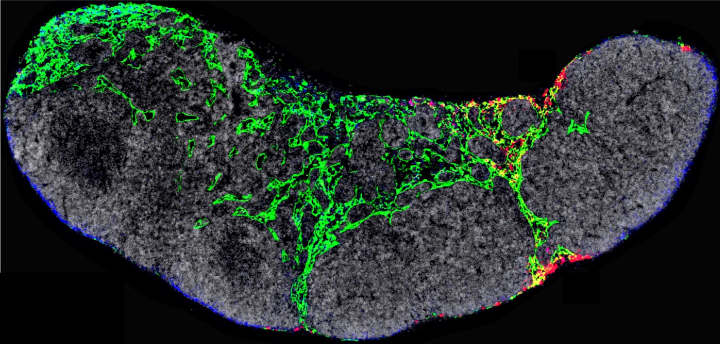Nerve growth factor receptor (NGFR) drives the process of early metastasis in melanoma, work from an international team of scientists has found. Additionally, blocking the molcule reduces metastasis in animal models.
The reduction was achieved using THX-B. This molecule is being tested for the treatment of other pathologies, which will accelerate its possible use in the treatment of tumors.
In order to fight tumors, researchers have typically focused on studying their intrinsic behavior, but not on their surroundings.
We must not only look inside the tumor but also outside of it,
said Héctor Peinado, a researcher at the Spanish National Cancer Research Centre (CNIO).
Exosomes And Metastasis
Peinado is the head of the CNIO’s Microenvironment & Metastasis Group, which studies the mechanisms involved in metastatic progression, including how nanoparticles called exosomes, which are released by tumors, manipulate the tumor microenvironment to favor metastasis. A recent paper1 describes how this critical process for melanoma progression occurs.
Exosomes travel to the sentinel lymph node — the lymph node where metastasis initially occurs — from where they remotely prepare a favorable environment, the pre-metastatic niche, for metastasis. In this study, the researchers observed that the NGFR molecule drives this entire process.
The scientists also propose NGFR as a new biomarker of early melanoma metastasis to define risk groups and predict metastasis.
A higher number of NGFR-expressing metastatic cells in the sentinel lymph node correlates with a worse disease prognosis,
said Susana Garcia Silva, co-first author of the study.
Tumor Microenvironment
Although exosomes — nanovesicles released by all cell types, including tumor cells —were discovered more than 30 years ago, they have not been widely studied until the last few years. In 2012, Peinado discovered2 in David Lyden’s lab in the U.S. how tumor cells release exosomes, which transfer biological information to the surrounding microenvironment to instruct it and promote metastasis even before the tumor cells themselves travel through the body.
Until a few years ago, the microenvironment surrounding the tumors was overlooked. Now we know that the communication of tumors with their local environment and the rest of the organism is fundamental to understand cancer and its complications,
said Peinado in 2015.
Melanoma cells, like many cells from other tumors, travel and spread through the body mainly via the blood circulation and the lymphatic system. These circulating tumor cells settle in the lymph nodes, which act as a reservoir or warehouse, and from there they carry out the changes for the formation of the pre-metastatic niche that will favor the colonization of other organs.
After seven years of extensive analysis, the researchers now state that exosomes released by melanoma cells are recruited by lymphatic endothelial cells in the lymph nodes. In these cells, the exosomes promote, via the NGFR molecule, further branching of the lymphatic vasculature and adhesion of tumor cells that will allow them to survive and migrate to other sites.
Melanoma cells secrete exosomes carrying NGFR to manipulate the behavior of lymphatic endothelial cells and facilitate metastasis, they explain.
THX-B
It was known that melanoma cells which begin metastasis increase NGFR production, but nothing was known about a possible role of NGFR in exosomes and its effects outside the tumor.
After discovering the role of this molecule in the early development of melanoma metastasis, the team decided to study the consequences of blocking it during tumor cell expansion in mice. To do this, they used a genetic approach, in which they eliminated NGFR from the exosomes, and a pharmacological approach, in which they used the NFGR inhibitor THX-B.
In both cases, metastasis was drastically reduced, opening the way to a possible new treatment to combat metastasis.
This may become one of the first treatments to tackle metastasis in its earliest stages when it is most likely to be successful.
The inhibitor THX-B is being studied for the treatment of other diseases such as diabetic retinopathy, but its effectiveness in the treatment of cancer has not been explored.
The study also shows that the number of metastatic cells expressing NGFR in lymph nodes predicts disease progression in melanoma patients.
The work was supported by the Starr Cancer Consortium, the US NIH, the Nancy C. and Daniel P. Paduano Foundation, the Children’s Cancer and Blood Foundation, the Melanoma Research Alliance, the Feldstein Foundation, the Fundación Ramón Areces, the Fundación Bancaria ‘la Caixa’ and the Fundación Científica AECC.
- García-Silva, S., Benito-Martín, A., Nogués, L. et al. Melanoma-derived small extracellular vesicles induce lymphangiogenesis and metastasis through an NGFR-dependent mechanism. Nat Cancer (2021). ↩︎
- Peinado, H., Alečković, M., Lavotshkin, S. et al. Melanoma exosomes educate bone marrow progenitor cells toward a pro-metastatic phenotype through MET. Nat Med 18, 883–891 (2012) ↩︎
Last Updated on October 1, 2022
